|
The Historic Development
of St. Stephen’s. Part 2
The 1920s and
1930s saw the growth of a movement to end the parallel
systems of elementary and secondary education and to
replace them by an end-on system of primary and
secondary education. The Hadow Committee report of 1926
concluded that education should be conceived in two
stages; Primary and Secondary, with a break at about 11.
Before this time organisation was vague, with no defined
system of age grouping.
St. Stephen's
log book records the expansion of the school to include
children of all school ages, from infant up to the age
of 14 in (1923) in a building originally intended for
children aged 5 to 10 years. In 1931 the system altered
throughout the town as the log book records "The Staff
have been engaged during the last 3 days with clerical
work owing to reorganisation. All children of 11 years
of age have been transferred to senior schools in the
town, and St. Stephen's School will be a Junior Mixed
School from 13th April, 1931."
The above system
was implemented in Wolverhampton in 1931, in order to
coincide with the intended raising of the compulsory
1eaving age from the age of 14 - 15 years scheduled in
1931. The latter did not take place however, but the
reorganisation did go ahead. |
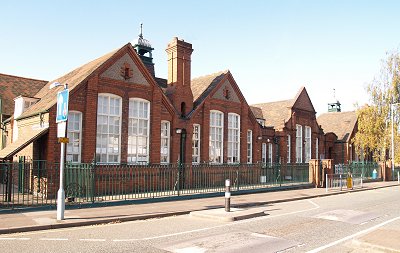
St. Stephen's School, as it is today.
|
The Hadow Report
of 1926 also suggested alterations in the curriculum.
Under the influence of John Dewey, the report stressed
that the curriculum should be thought of in terms of
activity and experience rather than of knowledge to be
acquired and facts to be stored.
For example
English was re-assessed in terms of ora1 work as much as
written routines. The Hadow Committee pressed for
younger children to be taught less through subjects and
more through manual and aesthetic experience, integrated
schemes and project work. The log book of St. Stephen's
records attempts at such teaching methods. Children were
taken on many educational visits and group teaching was
adopted to allow "specialisation".
In 1922
Wolverhampton held an Education Week when all the
schools in the town presented something to everyone
else. This took the form of a pageant with a procession
and different displays provided by the schools, on the
route taken.
The first
schools music festival took place in 1934 in
Wolverhampton. This gave the children an aim in music
lessons. Many schools in the town took part, each
singing before the others, and it is a practice that
continues to the present day. Along the same lines, a
sports day was held in the same year at Molineux
football ground, in which many schools from the town
took part, and this also continues annually, although
the venue is now the purpose built Aldersley Sports
Stadium. |
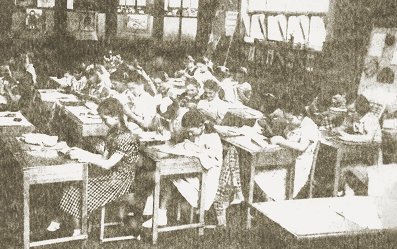
One of the old classrooms. Courtesy of Peter
Waterhouse.
|
The first
recorded open day at St. Stephen’s, at which parents
were able to visit the school, talk with the staff and
see examples of their children’s work, was held in July
1936 and these then formed an annual part of the school
timetable. The H.M.I. report of 1938 on St. Stephen’s,
records that "new activities are contributing to greater
interest in formal activities" in accordance with the
recommendations of the Hadow report.
The outbreak of
the Second World War affected education generally. The
first indication of the war in St. Stephen’s log book is
in September, 1938 when the head teacher was "summoned
to a meeting of head teachers in connection with the
recent international unrest." Air raid precaution
lectures followed and in September of the following
year, the re-opening of school after the summer holiday
was delayed due to the outbreak of war. A normal
timetable was attempted from November of tat year, but
air raids disturbed the intended lessons. Undeterred,
the log book records how these lessons were continued in
the air raid shelters.
Evacuees from
the cities vulnerable to attack, were drafted into
Wolverhampton and the log book records how 16 evacuees
were on the roll in September, 1944. Attention was
devoted in war time, more than ever before, to the
health of the children. At St. Stephen’s on 20th
October, 1941 "The Feeding in Schools Scheme" was
started. The log book records how 36 children stayed to
a hot dinner at the cost of 6d per day for juniors and
4d a day for infants. The school meals service grew
enormously. Some 1.5 million children nationwide, were
taking school meals before the war ended. Three times
the pre-war figure. |
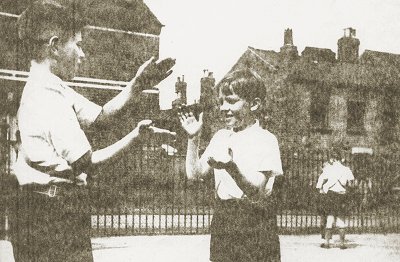
A game at play time. Courtesy of Peter
Waterhouse.
|
Nutrition and
general health were very important issues in the war
years. St. Stephen’s log book records many nutrition
surveys throughout the war. Milk started to be given to
the children at playtime. Immunisations against
Diphtheria began to take place and there were frequent
medical inspections of the children.
In 1940 the
schools in Wolverhampton remained open all year in order
that the parents of the children might work towards the
war effort knowing their children were being cared for.
The log book of St. Stephen’s records how teachers
staggered their week’s holiday in order that there might
be a permanent staff.
July 15th, 1940.
"It has been decided by the Education Committee that
members of staff should receive a week's holiday each,
but the schools should remain open during July and
August." After the war there was a profound agreement on
the need to finish re-modelling education and to
radically re-appraise educational needs and aims. In
1942 Mr. R. A. Butler became President of the Board of
Education and work was begun on the Education Bill which
came before Parliament for its first reading in
December, 1943 and received the Royal Assent in August,
1944. The most important provision of the 1944 Education
Act was that which proclaimed that "Public Education
shall be organised in 3 progressive stages to be known
as Primary Education, Secondary Education and Further
Education." The School leaving age, originally scheduled
to be raised in 1931, was raised to 15, in 1945.
Local Authorities were obliged to
provide school meals, free milk and regular medical
inspection. A new settlement was reached with the
Voluntary Schools, given their inability to cope with
reorganisation costs, they were given the choice of
accepting "controlled" status under which the L.E.A.
would meet all the school's expenses, or aided status,
under which the authority would pay for the running of
the school and half the capital cost of adapting the
school to meet the requirements of the Act. |
|
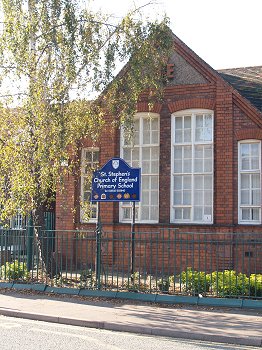
A view of the school from Woden
Road. |
In all schools a
daily act of collective worship was made a requirement,
along with religious instruction, based on an agreed
syllabus (agreed between the L.E.A. and the religious
bodies.)
The report
proposed the establishment of a central body to
supervise the training of teachers, for the committee
was anxious to raise the status of the teaching
profession. To meet post-war needs, a scheme for the
emergency training of teachers was introduced and over a
period of 6 years, some 35,000 prospective teachers
attended one year crash courses, some in colleges opened
especially for the purpose.
St. Stephen's
log book records how a "temporary unqualified teacher
awaiting acceptance at an Emergency Training College"
came to assist the staff in February 1945.
|
|
From 1950
onwards the main problem dominating schools in
Wolverhampton has been that of immigration. In 1955
there were over 27,000 immigrant children in schools
throughout Wolverhampton, and the number of children of
minority ethnic groups has risen since then. In addition
to immigrant numbers rising, the post-war population
trends are marked by the increased birth rate.
The post-war
bulge and the raising of the school leaving age to 15,
dramatically increased the number of children in grant
aided schools in England and Wales, from just over 5
million in 1946 to dome 7 million in the early 1960s.
The character of
the catchment area reflected changes in society and
environment in the early post war years. The housing
attracted many newcomers in the minority ethnic
groupings, and the percentage of these minority group
children was (and still is) very high. This brought
additional problems, particularly concerned with
language. |

The old boys' entrance. |
|
With such social
and educational difficulties, classes need to be kept
small, indeed, one of the main struggles in post-war
primary education was to reduce the size of the classes.
Pressure to set a target of 30 children to a class, in
primary as well as secondary schools, began to mount. A
stimulus for further change in primary schools was given
by the publication in 1967 of the Plowden Report on
Children and their Primary Schools. The basic philosophy
of the report was influenced by research into child
development including that of Piaget, a French
psychologist, favouring a balance of individual and
class work. The committee put forward a programme for
closer contact between schools and parents, and was
particularly concerned with what it termed "Educational
Priority Area Schools." St. Stephen's is such a school,
situated in a deprived area of the town where the
children need experiences of all kinds at school.
Areas which
qualified for E.P.A. status under the Plowden Report’s
recommendations were given special financial help - £16
million for a special building programme in 1968 for
example. It is out of this special building grant that a
new St. Stephen's School was built. In September 1970 a
new building on Long Ley, Heath Town was opened,
approximately one mile away from the old building on
Grimstone Street. This new building was a modern open
plan school, providing opportunities for group work and
a more flexible timetable, as envisaged in the Plowden
report. The official opening took place on July 13th,
1970, but by April, 1971 there was a single class back
in the old building on Grimstone Street, since the new
building was already overcrowded.
In 1971 the
Conservative Government withdrew free milk except for
children under 8 or in special schools for whom it was
recommended on medical grounds. The price of school
meals rose by one third from 9p to 12p. Education was
becoming in many respects, more exposed to the pressures
of economic and political policy.
Closer
relationships between parents and schools had been
fostered since the Second World War, by the
establishment of parent-teacher associations. In many
schools an involvement between school and community
became an integral aim of education and St. Stephen’s
was no exception to the rule. For example, at St.
Stephen’s parents are welcome to attend the school
assembly on a Friday afternoon, which is presented by a
different class each week. The head teacher is always
available for discussion and the parents are made to
feel welcome.
Some parents
assist in the school as ancillary helpers and this is
particularly valuable in the yearly programme of
educational visits arranged, making the ratio of adults
to children more advantageous. At fund raising efforts,
open days and sports activities and performances, the
involvement of parents and friends, both active and
passive, is considered vital. It is only in the
Governing body that there is no parental involvement,
this being a church school, although the 1980 Education
Act, with the section dealing with Governing Bodies,
will alter this. |
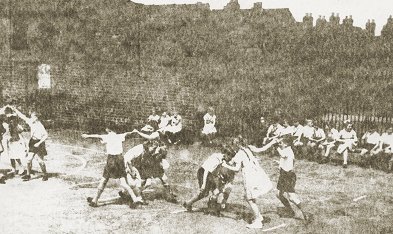
Play time. Courtesy of Peter Waterhouse.
|
The physical
movement of the School site from Grimstone Street to
Long Ley in 1970, heralded a new era. The school roll
increased from 76 some eighteen months prior to the
move, to 330 in September, 1971. The high "bulge" years
coupled with a rehousing programme in the School area,
the continued influx of minority ethnic groups
particularly from Jamaica and the Punjab, increased the
school roll to its maxim of 556 by 1974. The former site
in Grimstone Street was re-occupied and by this time
housed a little under 250 children under the direction
of the Deputy Head.
Pressures for
school places in the area as a whole was increasing, and
the authority put in a plan for reorganisation of both
secondary and primary education. The establishment of an
area comprehensive school on a site formerly occupied by
a girl's secondary modern and an infant school, the
building of a new church junior school and a new church
infants school in the adjoining parish of Holy Trinity,
enabled the boy's secondary modern school
(coincidentally housed in the original St. Stephen's
Springfield buildings) to transfer to the new
comprehensive site. This left vacant the secondary
Springfield Road site which was converted to house
separate infant and junior schools from Woden Road.
These premises
in turn were modernised to provide the fourth home in
ninety-eight years for St. Stephen's. During the period
of conversion work, St. Stephen's was housed on three
sites, Long Ley, (ten classes), Grimstone Street (six
classes), and Woden Road, (two classes)
In September
1977 the first stage of the St. Stephen's reorganisation
took place when a little over 200 children drawn from
the Long Ley site, the Grimstone Street site, the Woden
Road site, and a transfer intake from Park Village
Infant School, were registered as pupils of St. Stephen'
s.
Approximately
100 children remained at the Grimstone Street site,
which continued to function as an annexe for the next
twelve months and 200 children were left behind at the
Long Ley site to form a new Long Ley Primary School.
In September
1979 the Grimstone Street site closed for the second and
final time (the building being transferred to the Youth
Service) and St. Stephen's occupied the whole of the
Woden Road site. In October 1979, St. Stephen's opened a
nursery class and so provision was complete. The school
roll climbed to around the 350 mark and despite the
falling roll situation being experienced in other areas
of the Borough, fulfilled the planner's expectations.
On March 1st,
1980, the centenary was reached. During this time the
school had had four separate "homes" Springfield Road,
Grimstone Street, (also known as Hilton Street) Long Ley
and Woden Road. The school roll had fluctuated between
72 children at the end of the first week in March, 1880
to an all time low of 64 in 1961, to an all time high of
556 in 1974 to 353 by March, 1980.
Head Teachers
had held reins of office, pupil teachers had come and
gone, unqualified assistants had come and gone, students
awaiting entry to college, teaching as unqualified, had
played their part. Members of staff had included many
nationalities, Malayan, Italian, Polish, Jamaican,
Punjabi, Hindu, and Sikh.
Staff members
had held high positions within the education
infra-structure, including President of the Head
Teachers Association, Teacher Representative on the
Education Committee, and President of the Wolverhampton
Teachers Association.
School Meals by
container, cooked on the premises and by container
again, had come and stayed. Holiday and school visit
programmes had given pleasure and learning to many
ranging from the half day visit to places of interest
close by, to camping, Youth Hostelling, and Residential
Centres for both infant and junior age ranges. The
curriculum has developed both in style and span. An
involvement in the community, and the environment
started in the early days has continued and developed.
This then is St.
Stephen’s, 1981. |
 |
|
 |
|
 |
Return to History
of St. Stephen's 1 |
|
Return to
the beginning |
|
Proceed to
References |
|